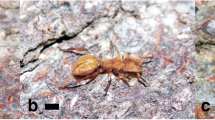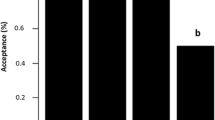Abstract
According to the weight and size of their prey, Ectatomma ruidum workers can employ different recruitment systems (solitary hunting, cooperative hunting and group hunting with recruitment) when mastering and retrieving prey items from short distances from the nest. Prey size determined the backwards entry typically adopted by this species, while prey weight determined the predatory strategy selected. After a common initial sequence (search for prey, detection, localization), predatory sequences varied in terms of the type of approach, the site of seizure, the reaction after stinging and the type of transport. Nevertheless, irrespective of prey weight and size, seizure was preferentially oriented towards the head and prey were always stung. Short-range recruitment and mass recruitment without trail laying were elicited by a large range of heavy prey (> 2.5 times the weight of an individual worker). According to the mortality risk associated with each prey, hunters exhibited a “prudent” stinging posture associated with an increase in the duration of the subsequent phase of waiting for prey immobilization. The overall time of capture was positively correlated with the weight of the prey. When collective hunting strategies were involved, E. ruidum colonies matched the number of recruited hunters to the size and weight of the prey. Compared to solitary hunting strategies, for short food–nest distances, this graded recruitment appeared to enhance the energetic benefits derived by this species from the use of recruitment systems: the higher the number of workers involved in the recruitment process, the greater the energetic benefits obtained. The exhibition or absence of trail laying behavior in the recruitment responses displayed by E. ruidum workers is discussed in relation to their involvement in scavenging or predatory behavior.
Similar content being viewed by others
Author information
Authors and Affiliations
Additional information
Received: 27 June 1996 / Accepted after revision: 3 March 1997
Rights and permissions
About this article
Cite this article
Schatz, B., Lachaud, JP. & Beugnon, G. Graded recruitment and hunting strategies linked to prey weight and size in the ponerine ant Ectatomma ruidum . Behav Ecol Sociobiol 40, 337–349 (1997). https://doi.org/10.1007/s002650050350
Issue Date:
DOI: https://doi.org/10.1007/s002650050350




